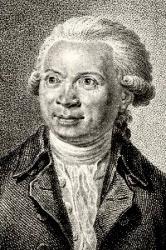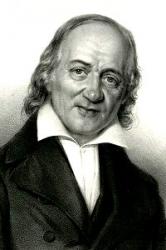Planning worship?
Check out our sister site, ZeteoSearch.org,
for 20+ additional resources related to your search.
- |
User Links
Person Results
J. A. P. Schulz

1747 - 1800 Composer of "[Wie ruhest du so stille]" in Glockenklänge Johann Abraham Peter Schulz Germany 1747-1800. Born at Luneburg, Germany, son of a baker, he attended St Michaelis school in Luneburg and studied organ, then the Johanneum from 1759-1764. In 1765 he was a student of composer, Johann Kimberger, and then taught in Berlin himself. In 1768 Kimberger recommended Schulz for the position of music teacher and accompanist to the Polish Princess Sapieha Woiwodin von Smolensk. Schulz moved to Berlin and traveled with her for three years performing throughout Europe, where he came in contact with many new musical ideas. He married Catharina Maria Gercken, and they had a daughter, Celle. He served as the conductor of the French Theatre in Berlin from 1776-1780. From 1786-1787 he was the Kapellmeister of Prince Henry in Rheinsberg. He began writing operas in 1785 and became musical director of the Berlin French theatre. Schulz went on to serve as Court Kapellmeister in Copenhagen from 1787-1795 before returning to Berlin. In Copenhagen the music library burned down, and he had a breakdown in health from trying to save it. His health suffered further from the effects of a shipwreck he experienced in 1796. Schulz wrote seven operas, stage music, oratorios, and cantatas, as well as piano pieces, folk songs, and church music. He also wrote articles on music theory for Johann Georg Sulzer’s ‘Allgemeine Theorie der schonen Kunste’ in four volumes. He died at Schwedt an der Oder, Germany.
John Perry
J. A. P. Schulz
Gottfried W. Fink

1783 - 1846 Person Name: Dr. W. G. Fink Composer of "[Wie ruhest du so stille]" in 349 Lieder Rv Gottfried Wilhelm Fink PhD Germany 1783-1846. Born at Sulza, Thuringa, Germany, he was a German composer, music theorist, poet, and a protestant clergyman. From 1804-1808 he studied at the University of Leipzig, where he joined the Corps Lusatia, where he made his first attempts at composition and poetry. In 1811 he was appointed Vicar in Leipzig for some years, where he also founded an educational institution, leading it until 1829. Around 1800 he worked for the “Allgemeine musikalische Zeitschrift” (General musical mazazine). In 1827 he became the magazine's editor-in-chief for 15 years. From 1838 he was a lecturer at the University of Leipzig. In 1841 he became a Privatdozent of musicology at the university. That year he became a member of the Prussian Academy of Arts in Berlin, and a year later was appointed university Music Director. He was highly esteemed throughout his life as a music theorist and composer, receiving numberous honors and awards, both at home and abroad. The Faculty of Philosophy at Leipzig University awarded him an honorary doctorate. He wrote mostly Songs and ballads and collected songs as well. He authored important words on music theory and history, but was best known as editor of the “Musikalischer Hausschatz der Germans”, a collection of about 1000 songs and chants, as well as the “Deutsche Liedertafel” (German song board), a collection of polyphonic songs sung by men. He died at Leipzig, Saxony.
John Perry
Gottfried W. Fink
Friedrich Adolph Krummacher

1767 - 1845 Person Name: Fr. Ad. Krummacher Author of "Wie ruhest du so stille" in Glockenklänge Krummacher, Friedrich Adolf, was a native of Tecklenburg, Westphalia, where his father, Friedrich Jacob Krummacher was Burgomaster and Hoffiscal. He was baptized there, July 22, 1767, and apparently born July 13, 1767. In 1786 he entered the University of Lingen (since 1819 ranked as a Gymnasium), and in 1787 that of Halle. After concluding his theological studies in 1789, he was for some time tutor in the family of Senator Meyer in Bremen; was then appointed, in 1790, Conrector of the Gymnasium at Hamm, and in 1793 Rector of the Gymnasium at Mors (Meurs), near Düsseldorf. In the end of 1800 he became Professor of Theology and Eloquence at the Reformed University of Duisburg. When, after the battle of Jena (Oct. 14, 1806), Duisburg was taken from Prussia, the salaries of the professors ceased, but Krummacher lectured on till his audience consisted of one student. He was then, in the autumn of 1807, appointed pastor of Kettwig, on the Ruhr; in 1812 Chief Court Preacher and General Superintendent at Bernburg; and finally, in 1824, he became chief pastor of the St. Ansgarius Church at Bremen. By reason of growing infirmities he resigned his charge in June, 1843, and died at Bremen, April 4, 1845 (0. Kraus, 1879, p. 310; Blätter für Hymnologie, 1886, p. 80, &c).
Krummacher is best known as a preacher; and as the author of the well-known Parabeln, first published in 1805, which passed through many editions, and ranks as the standard German work of its class. His hymns are little suited for church use, being often allegorical and high-flown, and not for the most part sufficiently simple and direct, though in some cases he does write in a popular, natural style, and with a beauty of his own. His hymns mostly appeared in his Festbüchlein, a work consisting of allegorical narratives, conversations, &c, with interspersed hymns. Of this the 1st part, entitled Der Sonntag, was published 1808 (2nd ed. 1810; 3rd ed. 1813; 4th ed. 1819); pt. ii., entitled Das Christfest, in 1810 (2nd ed. 1814; 3rd ed. 1821); and pt. iii., entitled Das Neujahrsfest, in 1819.
Those of Krummacher's hymns translated into English are:—
i. Allgemach aus Dammerung und Nacht. Advent. In his Festbüchlein, pt. ii., 1810 (1814, p. 154), in 5 stanzas of 4 lines, entitled "The Prophets of Nature"; and given after the conversation on Zacharias, the father of St. John the Baptist. Included as No. 34 in J. P. Lange's Deutsches Kirchenliederbuch, Zurich, 1843. The unity of idea is violated by the concluding lines of st. v.
"Wie die leisen Lispel den Propheten
Einst auf Horeb's Felsenspitz umwehten."
And thus in his preface, p. vii., Dr. Lange sug¬gests that st. v. should read thus:—
"Allgemach und siegreich fort und fort
Bricht durch unser Fleisch das ew'ge Wort;
Die Propheten grüsst es durch Gesichte,
Dann wird's Mensch und himmlische Geschichte."
Translated as:—
Slowly, slowly from the caves of night. A full and good tr. from Lange by Dr. Kennedy, as No. 42 in his Hymnologia Christiana, 1863.
ii. Eine Heerde und ein Hirt. Missions. First published in the 3rd. ed., 1821, of pt. ii. of his Festbüchlein, p. 163, in 6 stanzas of 6 lines, at the close of the section on "Israel and the Strangers." In the Berlin Geistliche Lieder Schatz, ed. 1863, No. 1365, and many other recent collections. The translations are:—
1. One, only One, shall be the fold. By Miss Dunn, in her Hymns from the Germany 1857, p. 49.
2. One Shepherd and one fold to be. In Cantica Sanctorum, 1880, No. 96.
iii. Ja furwahr! uns fiihrt mit sanfter Hand. Ps. xxiii. In his Festbüchlein, pt. i. (3rd ed. 1813, p. 118), in 5 stanzas of 4 lines, with Hallelujahs. It is given in the story of the festal rededication of a village church destroyed in time of war, as a choral hymn sung by boys and girls after the Holy Communion. In the Württemberg Gesang-Buch, 1842, No. 72. Translated as:—
1. Yes! our Shepherd leads with gentle hand, Through. A good and full translation by Miss Borthwick, in Hymns from the Land of Luther, 1st Ser., 1854, p. 59 (1884, p. 60), repeated in Kennedy, 1863; Mrs. Brock's Children's Hymn Book, 1881; the Christian Hymn Book, Cincinnati, 1865, and others.
2. Yea! our Shepherd leads, with gentle hand, Along. In full by M. W. Stryker, as No. 164 in his Christian Chorals, 1885.
iv. Hag auch die Liebe weinen. Love, Faith and Hope. Festbüchlein, pt. i., 1808, p. 136, in 3 st. of 4 1., in the section entitled "The Setting Sun," for Sunday evening. It is appended to a story in which the father has been speaking of the Resurrection of Christ the Sun of Righteousness, as celebrated on that day, the hymn being introduced as sung by the family and neighbours, as he ceased to speak. Included in the Württemberg Gesang-Buch, 1842, No. 628. It is most suited to be sung at a choral funeral. Koch, 2nd ed., iv. p. 695, says it was sung at the author's funeral at Bremen, April 10, 1845, and that st. iii. is on the cross over his grave. He adds that stanzas i., iii. were sung July 17, 1850, at the funeral of Dr. August Neander, the church historian in Berlin; followed by an address by Krummacher’s son, Friedrich Wilhelm (author of the well-known Elijah, Elisha and other works). Tr. as:—
Though Love may weep with breaking heart. A good and full translation by Miss Winkworth in her Lyra Germanica, 2nd Ser., 1858, p. 121. Repeated in Flett's Collection, Paisley, 1871, and in H. L. Hastings's Songs of Pilgrimage, 1887.
Other translations are, (1) "Let love weep,—It cometh," by Miss Warner, 1858, p. 584. (2) "Yea, Love may weep when death prevails," by Dr. G. Walker, 1860, p. 57.
A number of other pieces by Krummacher are translated in the Sacred Lyrics from the German, Philadelphia, 1859; by C. T. Brooks, 1847; by Mrs. Follen, 1851, and by Miss Fry, 1859. As they are poems rather than hymns they are not noted here. [Rev. James Mearns, M.A.]
--John Julian, Dictionary of Hymnology (1907)
Friedrich Adolph Krummacher


 My Starred Hymns
My Starred Hymns


